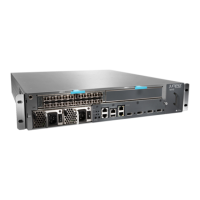Background 0 percent
Kernel 5 percent
Interrupt 1 percent
Idle 94 percent
Model RE-4.0
Serial ID P11123900322
Start time 2004-09-25 19:32:31 PDT
Uptime 9 days, 20 hours, 53 minutes, 8 seconds
Load averages: 1 minute 5 minute 15 minute
0.00 0.00 0.00
Routing Engine status:
Slot 1:
Current state Backup
Election priority Backup (default)
Temperature 29 degrees C / 84 degrees F
CPU temperature 30 degrees C / 86 degrees F
DRAM 2048 MB
Memory utilization 10 percent
CPU utilization:
[...Output truncated...]
Meaning The command output displays the Routing Engine slot number, current state (Master,
Backup, or Disabled), election priority (Master or Backup), and airflow temperature. The
command output also displays the total DRAM available to the Routing Engine processor,
the CPU utilization percentage, and the Routing Engine serial number for the slot.
Additionally, the command output displays when the Routing Engine started running,
how long the Routing Engine has been running, and the time, uptime, and load averages
for the last 1, 5, and 15 minutes.
Check the Uptime to ensure that the Routing Engine has not rebooted since it started
running.
To check the Routing Engine environmental status information, such as the operating
state, function, and operating temperature, use the following command:
user@host> show chassis environment routing-engine
Routing Engine 0 status:
State Online Master
Temperature 28 degrees C / 82 degrees F
Routing Engine 1 status:
State Online Standby
Temperature 29 degrees C / 84 degrees F
Check the LCD display on the craft interface to view information about the router
temperature and the status of the Routing Engines.
Related
Documentation
Checklist for Monitoring the Host Subsystem on page 367•
Checking the Control Board Status
Purpose To monitor the Control Board as part of the host subsystem on T320 and T640 routers.
For more information about monitoring the Control Board, see “Checklist for Monitoring
the Control Board” on page 381.
Action To monitor the Control Board environmental status, use the following CLI command:
379Copyright © 2012, Juniper Networks, Inc.
Chapter 13: Monitoring the Host Subsystem

